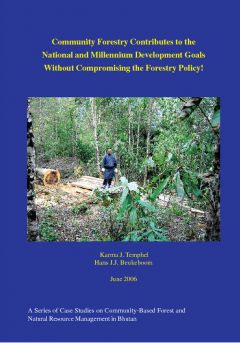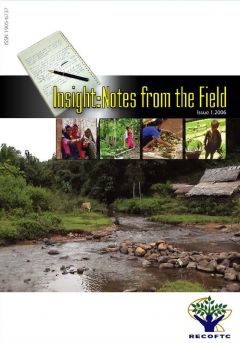Where are the poor and where are the trees?: targeting of poverty reduction and forest conservation in Vietnam
This paper highlights the spatial linkages of forest quality with poverty incidence and poverty density in Vietnam. Most of the Vietnamese poor live in densely populated river deltas and cities while remote upland areas have the highest poverty incidences, gaps, and severities. Forests of high local and global value are located in areas where relatively few poor people live, but where the incidence, gap, and severity of poverty are strongest, and where the livelihood strategies are based on agricultural and forest activities.
Where are the poor and where are the trees?: targeting of poverty reduction and forest conservation in Vietnam (Vietnamese)
This paper highlights the spatial linkages of forest quality with poverty incidence and poverty density in Vietnam. Most of the Vietnamese poor live in densely populated river deltas and cities while remote upland areas have the highest poverty incidences, gaps, and severities. Forests of high local and global value are located in areas where relatively few poor people live, but where the incidence, gap, and severity of poverty are strongest, and where the livelihood strategies are based on agricultural and forest activities.
Contribution of Community Forestry to Protected Areas Management
In most countries in the region, local communities' use of forest resources is strictly regulated. The strategy of managing forests through stringent protection and regulation has in fact not been very successful in protecting forests in Asia, and has resulted in conflicts between enforcement officers and communities. New strategies are required that acknowledge the high costs and conflicts in classical protected area management approaches and look at complementary strategies for achieving conservation by working with, rather than against, local communities.
Assessment of land use changes in Aşağıdere watershed in Bartın-Ulus
In this study, land use changes between 1986-2001 in Bartın-Ulus-Asagıdere watershed area was determined. In order to determine the land use percentages in 1986, Forest Management plan has been taken into consideration. Land use data belonging to 2001 has been determined by making use of the observations in the study area and data obtained from Forest Management plan of the year 2001. Arcview 3.2 software programme were used to analyze, examine and evaluate the data.
Trends in forest ownership, forest resource tenure and institutional arrangements: are they contributing to better forest management and poverty reduction?
This FAO study document provides information on formal and legal basis of forests and forest management types in Odisha along with trends and changes; describes status and impact of forest management regimes including JFM, CFM and mainstream forest management; delineates lesson learnt and future challenges.
Rural Land Use Policy for Fiji.
The Rural Land Use Policy for Fiji is a national policy with a multi-sectoral approach. The general principle of this Policy is to determine responsibilities of the State, landowners and land users in the fields of sustainable rural development, land management, protection of natural resources, having regard to biophysical, cultural, social and commercial factors.Technical, institutional and legal framework will be strengthened and assessment will be carried out on agricultural land, pastures and forests to ensure efficient land use.
Insight: Notes from the Field, Issue I
Insight: Notes from the Field is a response to this need, and with this publication, we aim to give practitioners a forum to share field level cases and lessons in Community Forestry (CF) or Community-Based Natural Resource Management (CBNRM). In this edition of Notes from the Field, there are inspirational stories on Community Forestry in Thailand, development of Village Forest Councils in India, experiences on Public Hearing and Public Auditing in community user groups in Nepal, and how to improve buffer zone co-management in protected areas of Vietnam.
Community Forestry Forum: Regulatory Frameworks for Community Forestry in Asia
The Regional Community Forestry Training Center for Asia and the Pacific hosted the First Regional Community Forestry Forum for the Asia Region in Bangkok, Thailand, August 24 -26, 2005, providing a platform for senior level government delegates to discuss forestry policy frameworks and experiences from the region. Representatives from the governments of seven countries formed the principle group of participants, along with forestry and policy experts from a number of agencies working in the field of forestry in Asia.
Hanging in the Balance: Equity in Community-Based Natural Resource Management in Asia
How equitable are benefits and costs being shared in community-based natural resource management (CBNRM) programs? To what extent are the voices of marginalized groups shaping the design and implementation of community based resource management systems?
Dampak desentralisasi kehutanan terhadap keuangan daerah, masyarakat setempat dan tata ruang: studi kasus di Kabupaten Bulungan, Kalimantan Timur
The report describes the impacts of forestry decentralization on district finance, local communities and spatial planning, drawing on an 18-month research project in Bulungan District in East Kalimantan Province. It describes forestry management policies following the implementation of regional autonomy, and their impacts on district revenue and local livelihoods. The authors analyze district spatial planning, forest land use and community control over forest lands.
Domesticating forests: how farmers manage forest resources
Local people in South-east Asia are often cited as skilled forest managers. It is barely acknowledged that an essential part of this forest management does not concern natural forests, but forests that have been planted, often after the removal of pre-existing natural forests; forests that are cultivated not by professional foresters, but by sedentary or swidden farmers, on their farmlands; forests that are based not on exotic, fast-growing trees, but on local tree species, and harbour an incredible variety of plant and animal species.







